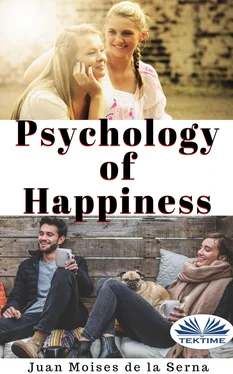Psychology
of
Happiness
The journey is now available to everyone
Juan Moisés de la Serna
Translator: Ana María Carrizosa De Narvaez
Tektime editorial
2019
“Psychology of Happiness: The journey is now available to everyone”
Written by Juan Moisés de la Serna
Translator: Ana María Carrizosa De Narvaez
1rst Edition: October 2019
© Juan Moisés de la Serna, 2019
© Tektime editions, 2019
All rights reserved
Distributed by Tektime
https://www.traduzionelibri.it
The total or partial reproduction of this book is not allowed, nor its incorporation into any computer system, nor its transmission in any form or by any means, be it electronic, mechanical, by photocopy, by recording or by other means, without the editor´s previous permission in writing. The infringement of the aforementioned rights may constitute a crime against intellectual property (Art. 270 et seq. of the Criminal Code).
Contact CEDRO (Centro Español de Derechos Reprográficos) if you need to photocopy or scan an excerpt of this work, you can contact CEDRO through the website www.conlicencia.com or by phone at 91 702 19 70 / 93 272 04 47.
Foreword
To talk about happiness means talking about an illusion, a goal in life, something very desirable but at the same time ephemeral. At least if we are referring to the idealized “happiness” sold through commercials, television or radio. But happiness is much more than achieving a desired goal in particular; it is a daily effort to maintain that state, otherwise, what would be the purpose of achieving happiness if we have to lose it afterwards?
In this book you will find the latest investigations related to happiness and the answers to what it is and how to achieve it. You will also find what happens if you don’t achieve happiness and what happens when the inconveniences and barriers to achieving happiness appear.
It will all be explained in a clear and simple way in order to offer you an enriching experience that will be able to help you in your personal search for achieving happiness; but a happiness that will be real, possible and attainable, and above all, lasting.
Surely many times
very happy you have been
but have you ever thought
why did it happen?
And why day after day
we are never happy?
Why is it difficult for us to smile
or make our brother happy?
Searching for an answer
roads I have traveled
I have asked many
no one has defined it.
—Happiness— they answer—,
I don’t know where it will come from
but I know I am happy
—someone will say so.
—Yes, I already know that
—to that one I have replied—
but tell me why.
—I don’t know —he has spoken.
Happiness sometimes
it’s hard to find
because we are demanding
and we don’t want to stop.
It is a quiet moment
that can be breathed
playing with a child
or looking at the wide sea.
It is only those moments
that you may remember
when you become overwhelmed
and cannot rest.
Happiness is that
what cannot be touched
a smile, a kiss
an “I love you, truly!”
It is always thinking about the other
selfishness forget
make an effort to smile
and think of others.
Dedicated to my parents
Index
CHAPTER 1. THE EMOTION OF HAPPINESS
CHAPTER 2. DISCOVERING HAPPINESS
CHAPTER 3. NEURONAL BASIS OF HAPPINESS
CHAPTER 4. SEARCHING FOR HAPPINESS
CHAPTER 5. THE BENEFITS OF HAPPINESS
CHAPTER 6. WHEN HAPPINESS DOES NOT ARRIVE
CONCLUSIONS
CHAPTER 1. THE EMOTION OF HAPPINESS
The first thing we need to know about happiness is that it is an emotion. Emotions are part of life, whether we are aware of it or not. They are present in each and every action and decision taken, hence the importance of studying them.
Among emotion theorists there are two perspectives: those who consider emotion as a univocal and inseparable concept that includes both positive and negative affect in a continuum; and those who consider it to be a multidimensional concept, composed of cognitive, behavioral and physiological elements.
Emotion can be considered as a particular state experienced by a subject, which allows him to perceive and respond to the environment (as a kind of arousal).
Simplifying, one could consider three possible states: the positive (joy or happiness), the neutral (indifference), and the negative (sadness, displeasure or unhappiness). Therefore, emotion would be a way of perceiving and responding to the environment.
When a state becomes chronic, it is considered to be a “trait” of personality, that is, the individual turns it into their usual way of responding to internal or external stimulation.
When chronic emotional states “get out of adjustment”, abnormal deviations of emotional processing appear, ranging from the accentuation of anxious or phobic traits, to pathologies such as generalized anxiety disorder or major depression disorder.
Another approach to emotion is to consider it as an adaptive procedure of cognitive, physiological and behavioral reaction to environmental or internal stimulation, which can be positive or negative. For those reasons, one can state that emotion has an impact in thoughts, as well as in the organism and in behavior.
The processing of emotion can be divided in two: emotional perception and emotional experience. The first one involves a low-level cognitive processing, where the emotional stimulus is perceived and evaluated; while the second involves a high-level cognitive processing where the perception is contextualized and interpreted according to previous experiences.
These processes appear to be independent; therefore, the processing of the emotional perception may or may not involve an emotional experience.
With regard to the relationship between cognition and emotion, there are three main stances:
- On the one hand, there are authors who defend that, in certain circumstances, the emotions block and nullify cognition, since the skills and abilities for affection are precisely the traits that characterize the human race in comparison with the simple mathematical and categorical processing of data that takes place in computers.
- The opposite posture defends that the superior cognitive processes define humans and differentiate them from animals. This posture relegates emotions to secondary, irrational and almost always equivocal processes, characteristic of animals.
- A third posture would be the one that considers both cognitive processes as independent, but working together in certain circumstances.
The existence of an emotional-perceptual-memory circuit in the human brain is widely accepted, with the amygdala playing a crucial role in registering the events of emotional stimuli. Thus, it is significantly more likely that the information with emotional content will be stored and retrieved better than the information with neutral content.
The extensive connection between the amygdala, the extrastriate visual regions and the hippocampus, allows the amygdala to modulate it’s functioning and facilitate perceptive and mnemic functions in these areas.
However, evidence shows that emotional learning associated with the amygdala is temporarily limited and that the subsequent effects on memory may be due to the participation of other brain regions, like the orbitofrontal cortex.
As previously mentioned, we would be facing an emotional processing circuit different from the specific cognitive processing path.
In the emotional circuit, the stimuli seem to be automatically analyzed in a rougher and faster way, following a strategy of configuration. It is a simplified communication, but with information of great relevance, necessary for survival and for an adequate development within an ecological niche.
Читать дальше












